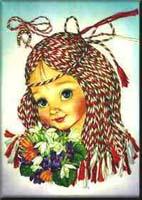Every year Romanian people knit two little tassels: a white one
and a red one. At the beginning of March, they offer this amulet to the
girls they love…
In Moldavia, part of Romania, all persons can receive a little March
amulet.
Red means love for everything that is beautiful and white symbolizes
the pureness and health of the snowdrops, the first flowers that appear
in spring.
That is the first celebration of spring in Romania.
The Story of the Little March
Once upon a time, there was an old woman. She had a son, March, who
had just got married. The old woman didn't like her daughter-in-low maybe
because she was too beautiful. That is why she was trying to find a flaw
in her son's wife ordering her the most difficult jobs.
One day the old woman commanded the girl to go to the river and to
wash some black wool until it would become white. Without a word the young
woman went to the river. There a young man appeared miraculously. He immediately
turned the black wool into white one. When he wanted to thank him he disappeared
leaving no trace behind him.
Another time, at the end of the winter, in February, the bad old woman
asked her daughter-in-low to bring her some wild strawberries. The girl
had no choice but to go find the wild fruits. March was desperate because
his own mother was torturing his wife. That is why he left his home.
Crying, the girl wandered throws the forest and suddenly the same handsome
young boy appeared and filled up her basket with wild strawberries.
The young lady hung at her neck a white coin for the wool and a red
one for the wild strawberries.
In her husband's memory whom she is still looking for, she called the
coins "Little March". From that day all the "Romanian girl and women wear
Little Marches".
They believe that the Little Marches bring them luck in love and good
health.
Povestea mãrtisorului
Trãia odatã o bãtrânã. Ea avea un
fiu, Martie, care tocmai se cãsãtori. Bãtrânei
nu-i plãcea de nora ei, poate pentru cã aceasta era prea
frumoasã. De aceea încerca sã-i dea nurorii ei cele
mai imposibile munci, ca sã îi poatã gãsi un
cusur.
Într-o zi bãtrâna ceru fetei sã meargã
la râu si sã spele niste lânã neagrã pânã
când aceasta se va face albã. Fãrã sã
zicã o vorbã, tânãra pleacã la râu.
Acolo apãru ca prin farmec un tânãr care transformã
imediat lâna neagrã în lânã albã.
Cãnd vru sã-i multumeascã, el dispãru fãrã
urmã.
Altãdatã, spre sfârsitul iernii, în februarie,
bãtrâna cea rea ceru nurorii ei sã-i aducã fragi.
Fata protestã, dar n-avu încotro, plecã în
cãutarea fragilor. Martie era disperat pentru cã propria
mamã îi chinuia sotia. De aceea plecã în lumea
largã. Plângând, fata colindã prin pãdure
si ca prin minune acelasi tânãr frumos apãru si îi
umplu cosul cu fragi.
Când bãtrâna vãzu fragii în cosul fetei,
muri imediat de inimã rea. Tânãra si-a atârnat
la gât un bãnut alb pentru lânã si unul rosu
pentru fragi. În amintirea sotului ei pe care îl cautã
si azi, ea le-a zis bãnutilor "mãrtisori".
De atunci toate fetele si femeile din România poartã,
începând cu Martie, mãrtisoare. Se zice cã acestea
le poartã noroc, sunt sãnãtoase tot anul si au noroc
în dragoste.
Cãtãlina Stoica
School 10 Focsani, Romania
|



